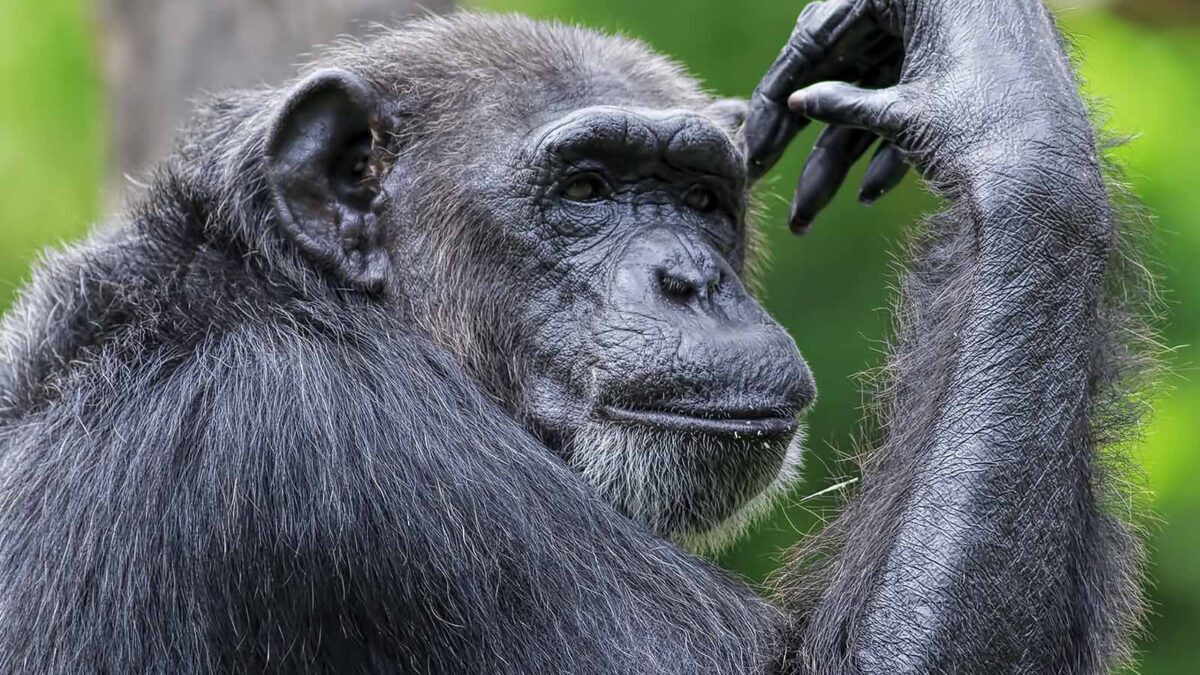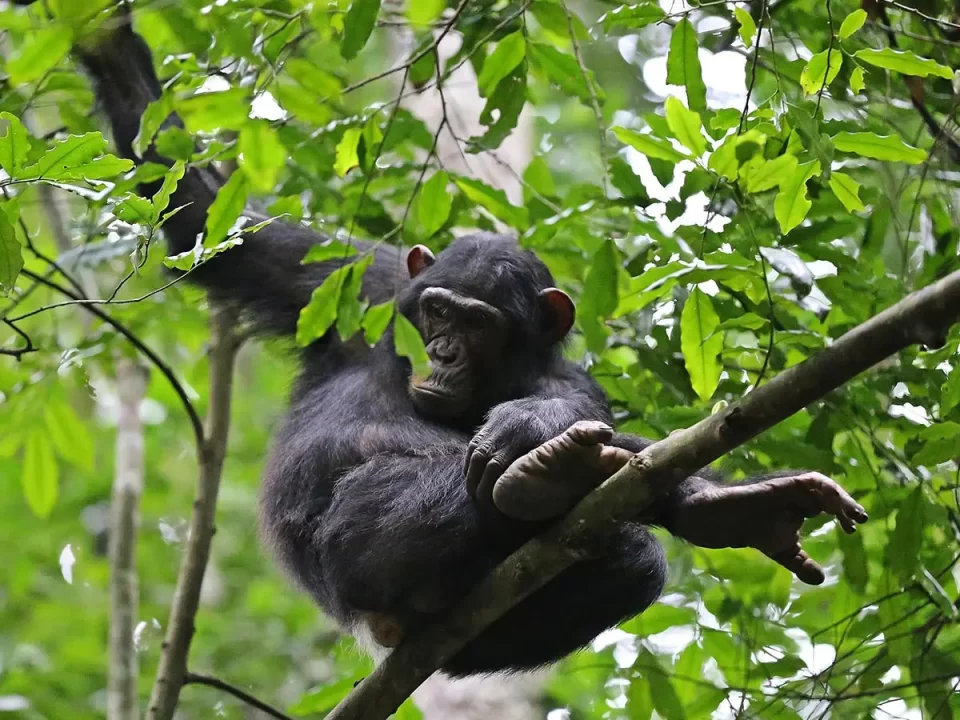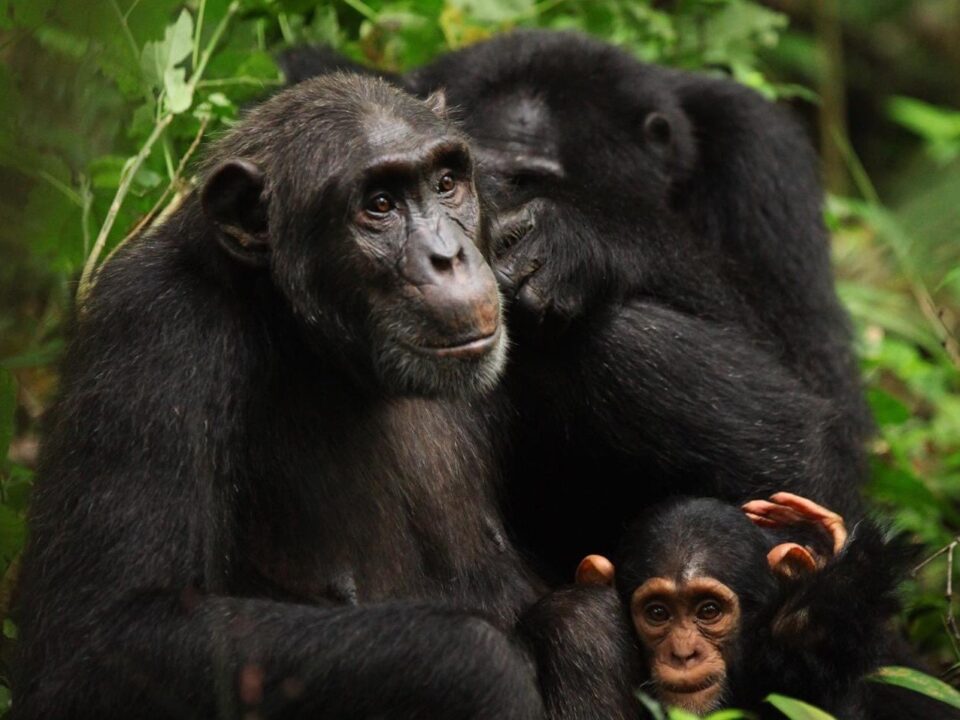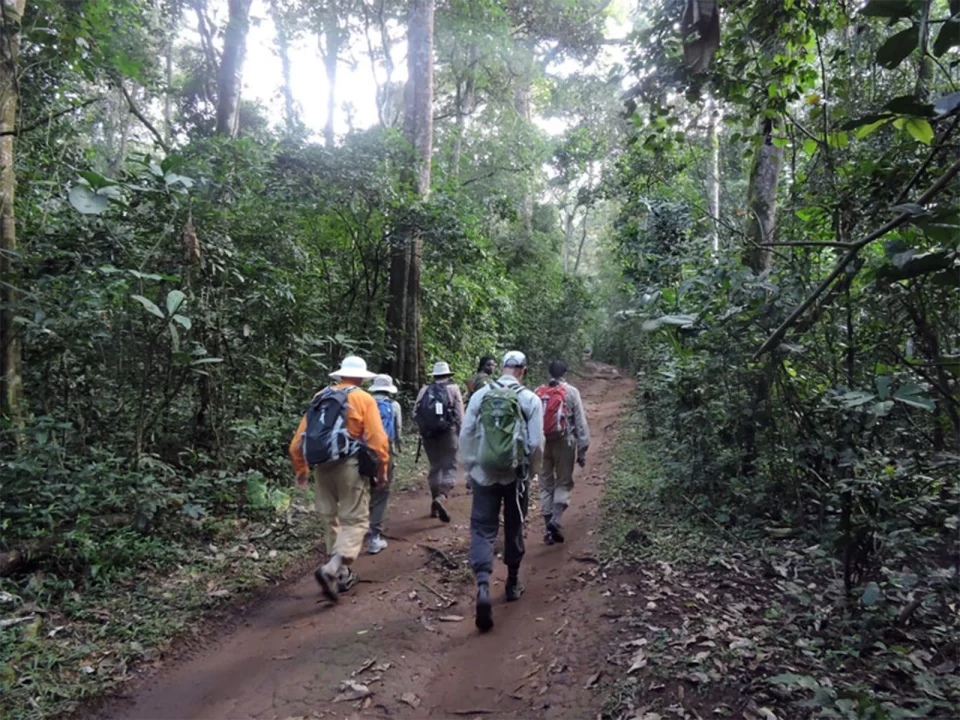Chimpanzee Tracking in Kibale Forest National Park

About Chimpanzee Trekking in Budongo Forest Reserve
July 25, 2023
Mountain Gorilla Trekking in Volcanoes National Park
July 25, 2023Chimpanzee Tracking in Kibale National Park:
Kibale National Park, spanning an impressive 795 square kilometers, is situated in western Uganda. The park’s diverse landscape includes lowland rainforests, woodlands, bushes, grasslands, and wetlands, extending through Kamwenge, Kabarole, Kyenjojo, Bunyangabu, and Kasese Districts. The forest terrain ranges from a minimum elevation of 1,100 meters above sea level in the south to 1,590 meters in the north. Originally gazetted as a forestry reserve in 1932, Kibale was later designated as a national park in 1993. The park enjoys a moist temperate climate, with average daytime temperatures around 27°C (81°F) and nighttime temperatures at 15°C (59°F). The annual average rainfall is about 1,700mm, with dry seasons occurring in December to February and June to July, while March to May experiences milder rains. The wettest period is from August to November, with occasional heavy storms lasting for days. The average annual temperature in the areas surrounding Kibale forest is 24°Celsius. These favorable weather conditions support a rich diversity of more than 350 plant and tree species, making it an ideal habitat for a wide range of wildlife, including 13 primate species, over 320 bird species, reptiles, insects, and more. Kibale National Park has earned international recognition for its thriving population of chimpanzees, making it a sought-after destination for chimpanzee tracking and chimpanzee habituation safaris.
Chimpanzees:
Chimpanzees (Pan troglodytes) are fascinating apes that share an astonishing 98.7% of their DNA with humans, making them our closest relatives in the wilderness. Covered in black hair, chimpanzees have bare faces, hands, toes, and hindquarters. With long arms and legs, they possess five fingers and toes, with thumbs separated from the other fingers and toes, enabling them to grasp and hold objects, use tools, and maintain stability while moving. Chimpanzees are skilled at both walking on all fours and on two legs, a behavior known as knuckle-walking. They occasionally carry items in their hands and walk solely on their legs when transporting or transferring objects.
Behaviors:
Chimpanzees are highly social mammals, living in communities that can reach up to 150 members, led by an alpha male. In the mornings, they split into smaller groups to forage for survival resources more efficiently. The alpha male is the authoritative leader, ensuring the community’s security, discipline, direction of movement, feeding and watering areas, and controlling routine activities. The alpha male also enjoys privileges such as mating and preferred access to food. Chimpanzees leave their nests at daybreak to search for areas with an abundance of food. They take a siesta at noon, engage in battle drills and mock fights, play games, act as guards and sentries, groom each other, and engage in various activities. Towards evening, they feed again before building nests at sunset to spend the night. Chimpanzees are generally quiet and inactive at night, except when facing threats such as predators, thunderstorms, or wild bushfires.
Diet:
Chimpanzees are omnivores with a diverse diet that includes fruits, plants, fresh vegetation, shoots, barks, rhizomes, root tubers, nuts, eggs, insects, grasses, and more. They are skilled hunters, and in groups, they capture and consume small antelopes, reptiles, birds, monkeys, rodents, and even fish from shallow streams, swamps, and ponds. While their preferred natural habitat is the rainforest, they can adapt and temporarily inhabit woodlands, grasslands, and wetlands to find essential resources for survival.
Threats:
Chimpanzees are classified as Endangered, with only an estimated 180,000-300,000 individuals remaining worldwide, and only around 800 estimated individuals in Budongo Forest Reserve. They have an average lifespan of about 35 years in their natural habitat. Natural predators for chimpanzees in the wild include leopards, lions, and crocodiles, while diseases, bushfires, and droughts also pose threats. However, the most significant threat to chimpanzee survival is human activity, such as illegal wildlife trafficking for zoos, cinema, pets, and scientific research. Some indigenous communities engage in trade involving chimpanzee body parts for rituals and ceremonies, hunt them for game meat, and harm them when they encroach on farmlands. Human interactions with chimpanzees can also lead to the spread of diseases and unnatural behaviors due to uncontrolled contact, littering, and careless waste disposal.
Chimpanzees with Humankind:
Chimpanzees and humans share an astonishing 98.7% DNA similarity. While chimpanzees can perform many activities similar to humans, they may do so at a slower pace. Both species have a similar dental structure, including molars, premolars, incisors, and canines. Like humans, chimpanzees use tools to achieve their objectives, such as dipping long sticks into water to estimate depths or using stones to crack hard nuts or scoop ants from anthills or honey from beehives. Chimpanzees, like humans, are highly social mammals that live in groups of related extended families, with each member playing a role based on age, gender, and ability. Female chimpanzees give birth to one baby (twins are possible) approximately every two years and take turns caring for infants. Chimpanzees have similar sensory abilities to humans, including forward-looking faces, color vision, a strong sense of smell to detect poison, and acute hearing. They also exhibit a high level of intelligence, awareness, and planning capacity, with the ability to memorize yearly events and trends and plan actions based on past experiences.
Chimpanzee Tracking:
Chimpanzee tracking is an exhilarating outdoor activity that involves groups of adventurers and travelers exploring the forests and wilderness alongside forest rangers, porters, and escorts in search of habituated chimpanzee families.
Best Tracking Time:
The timing of chimpanzee tracking in Kibale National Park is directly related to weather and climatic conditions. Various factors, such as the season, altitude, strong winds, vegetation, water bodies, human activities, tropical sun, and the park’s location along the equator, all influence the weather at any given time. Therefore, temperatures may be hot even during the rainy season, and rain can persist for several days in the dry season.
Dry Season:
The driest months in Kibale National Park are December, January, and February. During June and July, average daily temperatures range between 15°C (59°F) in the morning and 27°C (81°F) in the afternoon, making early mornings the most favorable time for chimpanzee tracking. The dry season is highly competitive for chimpanzee tracking, with permits and safari camps often fully booked. Chimpanzees tend to move deeper into the forests in search of food during this time.
Rain Season:
The rain season occurs from March to May, characterized by rains with brief breaks that may last for several days. The period from August to November receives the highest amount of rainfall, with the weather often being very wet. Rains result in streams, rivulets, and mud pools forming, and footbridges may become washed away. Vegetation flourishes during this time, providing plenty of fresh food for the chimpanzees, who tend to move closer to trail systems. Visitor bookings tend to reduce during the rainy season, and safari camps may offer promotional rates and discounted fees for chimpanzee tracking permits.
Guidelines for Chimpanzee Tracking:
To ensure a smooth, safe, and successful chimpanzee tracking expedition in Kibale National Park, visitors are advised to follow these guidelines:
- Procure a tracking permit through a trusted travel agency, specifying relevant details such as names, travel agency, tracking date and time, residence status, and fees paid.
- Assemble at Kanyanchu visitor center along the Fort Portal-Kamwenge Road one hour before the scheduled tracking time.
- Chimpanzee tracking has two shifts, at 8 am and 12 pm. Assemble for the respective shift an hour before the start of the exercise.
- Chimpanzee habituation allows visitors to spend an entire day with the chimpanzees, from 7 am to 6 pm.
- Declare your health status, confirm your booking, and make final preparations for the tracking expedition.
- Note that chimpanzee tracking is restricted to individuals above 15 years of age.
- Forest rangers will form groups of six visitors each and assign a forest ranger guide, escorts, and porters.
- Bring a lunch box and carry 2 liters of drinking water or non-alcoholic drinks.
- Chimpanzee tracking is a group activity, so stay together in the forest.
- Keep voices down and pay attention to the forest guides.
- Avoid eating, drinking, or smoking near the chimpanzees.
- Maintain proper hygiene, do not spit in the forest, and seek permission for nature calls.
- Do not litter in the park; dispose of any non-recyclable items in designated areas.
- Visitors spend approximately one hour interacting with the chimpanzees, depending on the conditions in the forest.
- Maintain a minimum distance of 8 meters between chimpanzees as a health precaution.
- Deactivate the flash and loud clicks on your camera to avoid irritating the chimpanzees.
- Deactivate the GPS on electronic devices before entering the forest.
- Do not mimic chimpanzees, show body gestures, or make abrupt body shifts, as this may provoke violent reactions from them.
- Wear appropriate clothing suitable for the prevailing climatic conditions during the chimpanzee tracking expedition, which typically lasts around four hours. Opt for light, dull-colored clothing.
- If needed, elderly or disabled visitors can bring a walking stick, which can be improvised on-site.
How to Dress Up:
Though no one has ever failed to complete a chimpanzee tracking expedition due to improper dressing, pre-planned dress codes can enhance the overall experience. Consider the following points when choosing your clothing:
- Face masks
- Long-sleeved safari shirts, blouses, jumpers, and tops in dull colors
- Safari trousers in khaki, jeans, or track suits in dull colors
- Waterproof hiking boots or rubber boots
- Light rain gear or a poncho
- Warm clothing in dull colors
- Strong stockings
- Hand garden gloves
- Headgear such as a round hat, cap, or headscarf
- Sunglasses are useful during the dry season
- Changing clothes in any color and design for onward safaris
What to Carry:
Adventurers can enhance their chimpanzee tracking safaris by packing essential items to make the expedition even more exciting. Consider bringing the following:
- A backpack
- Camera and rechargeable batteries
- Phone charger
- Binoculars
- A food box
- A water bottle
- Simple personal first aid items
- A field guide book, notebook, pencil, pen, and eraser
- A strong, rechargeable flashlight
- A compass
- A map
Accommodation:
For a convenient base from which to launch or relax after a chimpanzee-tracking expedition in Kibale National Park, the upscale Primate Lodge, located close to Kanyanchu Visitor Center, is an ideal option. The park’s surrounding areas, including Bigodi, Nkingo, and Isunga, offer multiple safari camps and lodges at the forest’s edges. Visitors can also find various urban accommodation options in Fort Portal City and Kamwenge town, which are situated nearby. Some highly recommended safari camps include Kyaninga Safari Lodge, Mountains of the Moon, Ndali Lodge, Aramaga Safari Camp, and others, offering outstanding experiences within easy reach.
Accessibility:
The easiest way to reach Kibale National Park and Kanyanchu Visitor Center is by a four-hour, 320-kilometer drive from Kampala through Mityana and Mubende. Fort Portal City, located in the foothills of the Ruwenzori Mountains, serves as the nearest urban center. Travelers from western Uganda can access Kanyanchu through the Mbarara-Ibanda-Kamwenge or Mbarara-Kasese-Fort Portal routes, while those coming from northern Uganda can get there via the Masindi-Hoima-Kyenjojo-Fort Portal route. For those who prefer air travel, airfields in Kasese and Fort Portal towns allow for private charter flights.
Other Tourism Activities:
In addition to chimpanzee tracking, Kibale National Park offers a variety of other exciting tourism activities, including:
- Forest Walks: Kibale Forest is home to various wildlife species besides chimpanzees, such as 12 other primate species, beautiful butterflies, and a diverse array of trees and plants. Exploring the forest on foot offers adventurers an opportunity to marvel at the captivating beauty and unique wonders of the wilderness. Walks can vary in duration, ranging from a few hours to multi-day treks.
- Bird Watching: Kibale Forest is a birdwatcher’s paradise, hosting over 320 bird species, including several Albertine Rift endemic species like the blue-headed sunbird, red-faced woodland warbler, collared apalis, dusky crimson wing, black-capped apalis, and purple-breasted sunbird. The park is an Important Birding Area and an ideal destination for birdwatching enthusiasts touring Uganda.
- Community Tours: The indigenous Batoro and Bakiga communities living around Kibale Forest offer a unique cultural experience. Visitors can learn about their lifestyles, dress, homestead setup, rituals, ceremonies, traditional food, hand tools, crafts, and more.
- Bigodi Wildlife Sanctuary: Located on the edge of Kibale Forest, this wetland sanctuary offers an opportunity to encounter various wildlife species that are less commonly seen during chimpanzee tracking. Visitors can interact with local communities in the area during their visit.
- Crater and Tea Estate Tours: The Kasenda area near Kibale Forest boasts a landscape formed by ancient volcanic activity, featuring beautiful craters, crater lakes, and other volcanic landforms. The tea estate tour provides insight into tea planting, care, harvesting, and processing.
- Royal Palace Tour: Kibale National Park is situated within the Toro Kingdom, where a cultural king administers traditional and cultural roles. A tour of the King’s palace at Harukoto offers visitors a glimpse into the traditional lifestyles of the Batoro people.
- Amabere Ga Nyina Mwiru: This unique land feature, formed by tectonic and volcanic forces, comprises caves that hold significant cultural importance for the indigenous Batoro people. A visit to the caves offers insights into the local cultural heritage.




